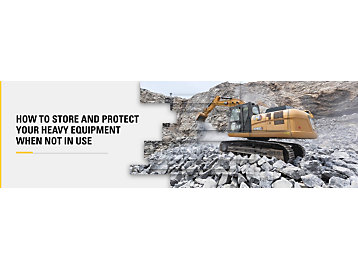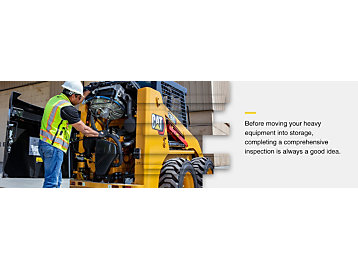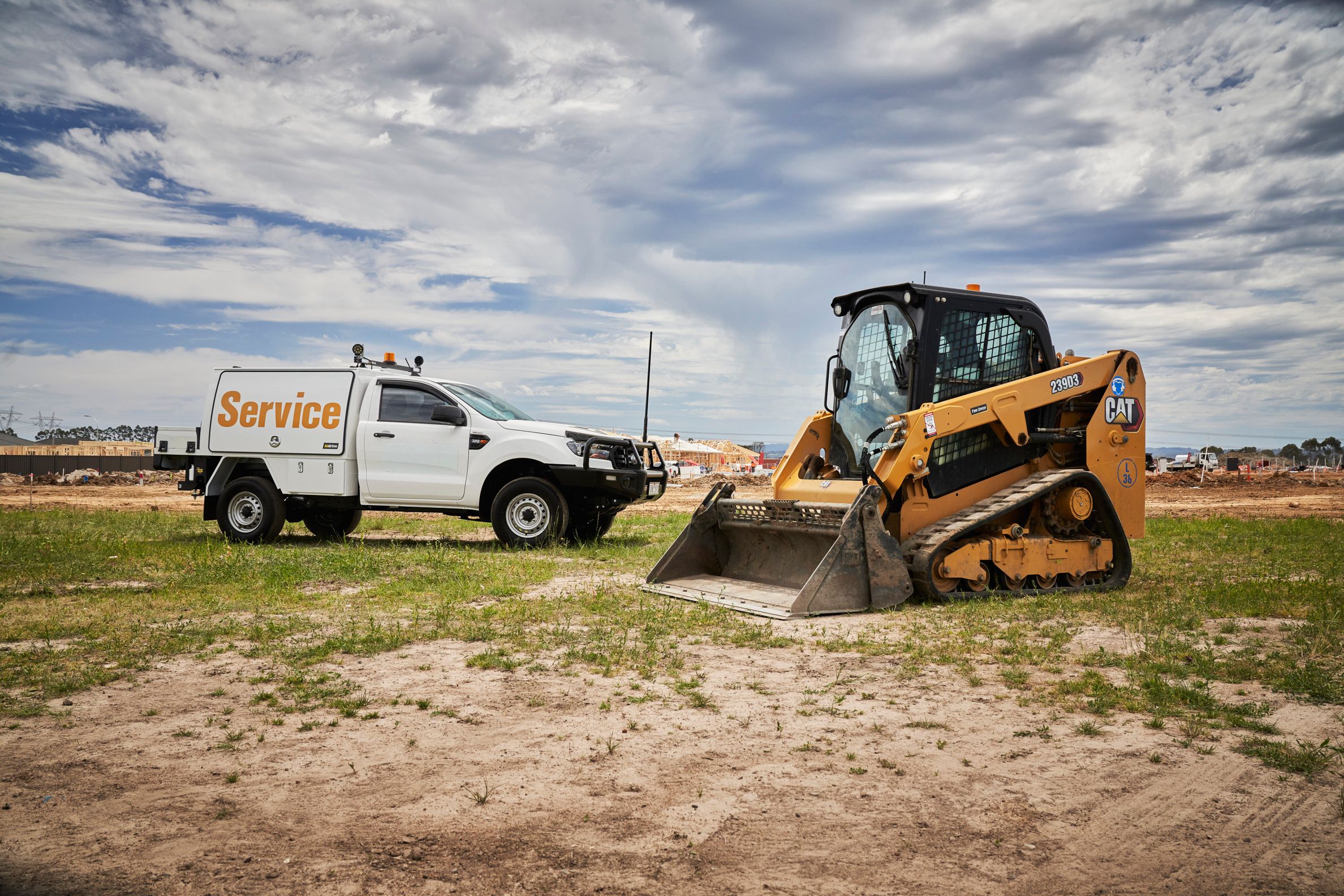

Sign In
Welcome! Sign In to personalize your Cat.com experience
If you already have an existing account with another Cat App, you can use the same account to sign in here
Register Now
One Account. All of Cat.
Your Caterpillar account is the single account you use to log in to select services and applications we offer. Shop for parts and machines online, manage your fleet, go mobile, and more.
Account Information
Site Settings
Security
Author: Small Business Expert | March 23, 2023 | Topic: Used Equipment

Whether your heavy equipment is at work on a construction site or parked for long-term storage, it requires special care. Following the best practices for equipment storage helps preserve its condition and elongate its life span.
If you own heavy equipment, you know you need to consider many factors to keep it safely stored away when it is not in use. Between maintaining the integrity of the equipment and preventing unwarranted use or theft, you've got to find the right solutions to protect your investment.
Explore our tips for heavy equipment storage to learn more.
How to Prepare Heavy Equipment for Storage
Protecting heavy equipment when it's not in use is essential for maintaining your machines and keeping them safe. When preparing for storage, be sure to do the following:
Inspect
Before moving your heavy equipment into storage, completing a comprehensive inspection is always a good idea. Your machine's operation manual likely has a pre-storage checklist to help you with this process. Look over everything and check for any damage or missing parts. You'll want to address these before putting your equipment in storage.

We suggest you do the following during your inspection:
- Check fuel levels: Ensure your fluids are all topped off to minimize water condensation in your machine.
- Examine windows and windshields: Check to see if there is an adequate seal around the windows and windshields on your equipment. If there is a crack or leak, it is best to fix this before putting it in storage.
- Test tire pressure: Be sure to test the tire pressure and add air to any tires with low pressure. Proper air pressure extends the life of the tires and helps prevent deterioration.
Clean
After inspecting everything on your equipment, it is beneficial to wash away any grease or debris thoroughly. Cleaning your equipment is crucial because even a small buildup of dirt and grime can cause corrosion and other problems. Don't forget to make sure the engine compartment is clean. You'll also want to declutter and clean the machine's cab by getting rid of dust and trash.
Lubricate
Before putting heavy equipment into storage, it is essential that you properly lubricate all machine components. Consult your owner's manual to find all the places where you should add lubricant. Doing so will help to reduce moisture and rust while the machine is not in use.
Repair and Replace
As the final phase of storage preparation, we suggest repairing and replacing any missing or damaged parts. This may include doing things like:
- Swapping out burnt-out light bulbs
- Tightening nuts and screws
- Repairing window sealants
It can be beneficial to record the items you repair and replace. This record will help you remember what maintenance tasks you did and when. Addressing minor damage before storage can save you a lot of money in the future.
Storage Options for Heavy Equipment
You have a few main solutions for storing heavy equipment that protect them from unfavorable conditions and keep them safe. Consider these choices when deciding where to keep your machines when they are not in use:
Warehouses
Whether you have your own warehousing or choose to utilize an off-site option, warehouses can be an excellent solution for storing heavy equipment. A warehouse keeps machines indoors and away from environmental factors like dirt and poor weather. It also helps keep equipment safe from thieves and unwarranted use. Just be sure the warehouse has around-the-clock surveillance.
Shipping Containers
Shipping containers are another storage solution that can be beneficial for heavy equipment storage. They are an inexpensive yet effective choice. Because shipping containers are watertight and durable, your machine will stay dry and safe from external factors. You can either rent or buy these containers. They're available in various sizes and shapes to fit your unique needs, and they often have the following features to help protect your equipment further:
- HVAC systems
- Lighting
- Insulation
- Electrical outlets
- Storage
You can also add a lock on a shipping container for added security.
Welded Mesh Cages
Another inexpensive storage solution for heavy equipment is welded mesh cages. You can set them up around your machine in various configurations to suit its size and shape. These cages are versatile, and you can also repurpose them for other uses. You can also add a lock to protect your equipment further and prevent unauthorized access. This option is easy and efficient but does not keep moisture and other environmental elements away from your equipment.
5 Heavy Equipment Storage Tips
When choosing the right storage solution for your heavy equipment, a few things can help you make the safest and most secure choice. Consider these tips to protect heavy equipment in storage:
- Install security cameras: Camera systems help minimize security and privacy risks and are essential for heavy equipment storage. Your machines are an investment, and you can protect them better if you have security cameras to keep watch over them. If you rent a space for storage, be sure they have adequate surveillance.
- Disconnect the battery: It is best to disconnect your equipment's battery before it goes into storage. This will help elongate its life and prevent battery discharge. You can store the battery somewhere cool and dry to properly maintain it. It is also beneficial to clean the battery connections to avoid corroded terminals that can cause trouble when you hook the battery back up.
- Protect equipment from the elements: Another essential tip is to protect your machines from the environment by keeping them out of direct sunlight and away from moisture. You can utilize a tarp or wrap to keep out pollen and dirt. One of the most important ways to protect your machine is by adding ground protections to keep it away from dirt and water.
- Lower any attachments: When you are ready to store your heavy equipment, it is best to lower its attachments. This position is both safer and better for the machine. It is also helpful to address missing or damaged parts on the attachment before putting it into storage. If you remove any attachments, ensure you also store them in a secure place away from the elements.
- Implement lockout/tagout procedures: Always employ lockout/tagout (LOTO) procedures before storing your heavy equipment to avoid unexpected energization or the release of hazardous energy. The Occupational Health and Safety Administration (OSHA) mandates proper LOTO practices to keep people and spaces safer.
Turn to Cat Used for Your Heavy Equipment Needs
At Caterpillar, we dedicate ourselves to providing top-quality equipment and services to our customers worldwide. Our dealers have reliable used equipment that can boost your operations without hurting your wallet.
Are you interested in used equipment that is cost-effective and reliable? Find a Cat® dealer near you today!


